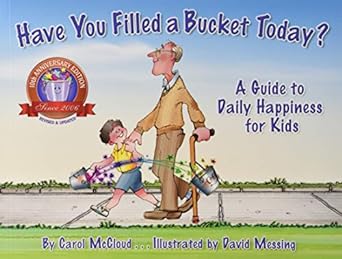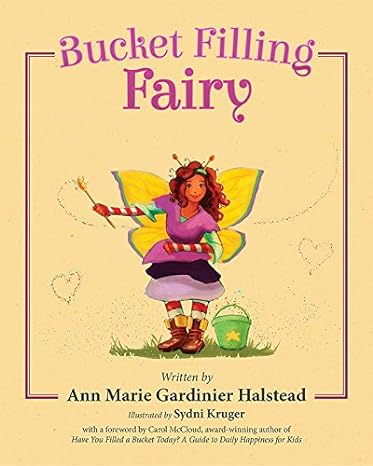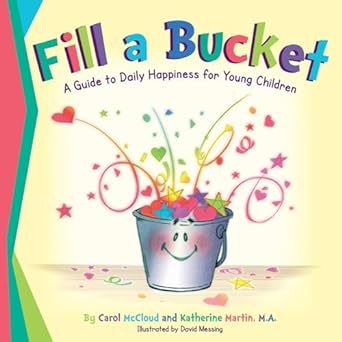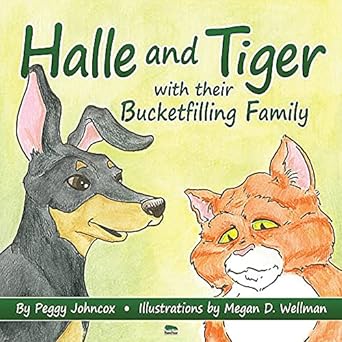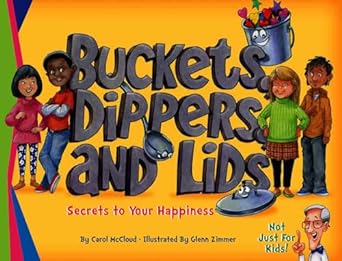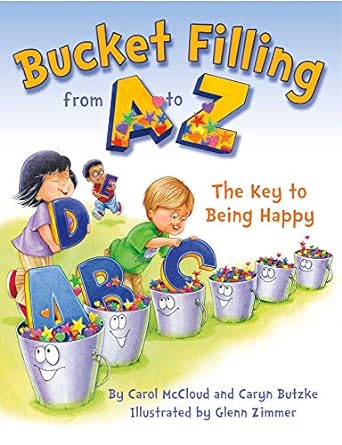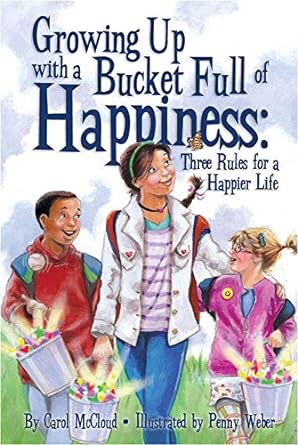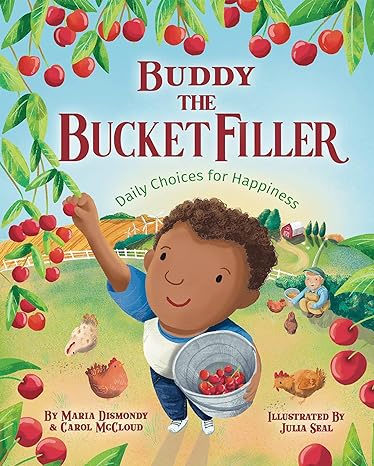Bucket Filler Book Guide: Nurturing Positive Growth in Child Development
In the vast world of children’s literature, The Bucket Filler Book has carved a distinctive niche, resonating profoundly with both kids and adults alike. These aren’t just stories; they are transformative tools that weave lessons of empathy, emotional understanding, and positive actions into captivating narratives. Lets delve into the captivating realm of the bucket filler book and discover how they play an instrumental role in nurturing a child’s holistic development.
Origin of the Concept
The notion of “bucket filling” can be traced back to the 1960s, primarily linked to Dr. Donald O. Clifton, a psychologist and the founder of Strengths Psychology. While Dr. Clifton may not have written children’s books on the topic, his work forms the foundational concept behind the idea of filling and dipping from emotional buckets.
The Invisible Bucket Analogy
Every individual, according to Clifton’s theory, carries an invisible bucket. This bucket represents their emotional and mental well-being. At the core, the bucket signifies our current state of emotion – whether we feel happy, fulfilled, and positive, or drained, negative, and unsatisfied.
The idea is beautifully simple yet profound: Throughout our day, our interactions with others can either “fill” or “dip” into our bucket. When someone compliments us, shows kindness, or supports us, it adds to our emotional bucket, making us feel valued and happy. On the other hand, negative actions or words can “dip” into our bucket, depleting our positive emotions.
Interconnected Buckets
But here’s the truly groundbreaking insight: our buckets are interconnected. When you fill someone else’s bucket, you’re not just enhancing their well-being; you’re also filling your own bucket. Kindness and positivity ripple back. Conversely, when you dip into someone’s bucket with negativity or harm, your own bucket isn’t spared; it takes a hit too.
Impact on the Modern Positive Psychology Movement
Dr. Clifton’s bucket theory, in many ways, paved the path for the positive psychology movement. It emphasizes focusing on strengths, positive interactions, and the significance of daily encounters on our mental and emotional health.
Transition to Children’s Literature
While Dr. Clifton didn’t frame his work for children, the principle is universal and timeless. Authors, educators, and parents saw the value in teaching children about the impact of their actions and words on others. This led to the creation of a ‘Bucket Filler Book,’ a collection of children’s literature that beautifully encapsulates the idea for young minds.
Each bucket filler book listed below uses engaging stories and relatable scenarios to introduce children to the concept of their own invisible buckets. They teach kids that through acts of kindness, love, and understanding, they can fill others’ buckets and, in the process, fill their own.
It’s truly a transformative concept that, when understood at a young age, can mold an individual’s approach to interpersonal relationships and self-awareness for a lifetime.
How A Bucket Filler Book Can Influence Child Development
Introducing children to a Bucket Filler Book does more than just entertain them. These books play a crucial role in nurturing holistic child development. Let’s explore their profound impacts:
Emotional Development
- Awareness of Emotions: Children start recognizing and understanding their own emotions better. They can associate their feelings with the state of their “invisible bucket” and articulate if they’re happy (bucket is full) or upset (bucket is dipping).
- Emotion Regulation: Kids learn that they have control over their emotional states. If they’re feeling down, they can seek out positive interactions to help fill their bucket.
- Empathy and Compassion: By realizing that everyone has a bucket, children begin to develop empathy. They become more compassionate, understanding that their actions directly influence the emotional well-being of others.
Cognitive Growth
- Cause and Effect Understanding: The bucket metaphor provides a clear representation of cause (actions) and effect (emotions). This helps children grasp the concept that their behaviors have consequences, be it positive or negative.
- Decision-making Skills: With the bucket concept, kids can evaluate which actions will fill buckets and which might dip from them. This evaluation improves their decision-making skills over time.
- Abstract Thinking: While the bucket is a tangible concept, its representation of emotions introduces children to abstract thinking, helping them visualize intangible concepts like feelings and well-being.
Social Development
- Improved Interactions: As kids become more aware of the bucket concept, their interactions with peers improve. They’re more likely to engage in positive behaviors that fill the buckets of their friends and family.
- Conflict Resolution: When children understand that negative actions dip into someone’s bucket, they’re more likely to find peaceful solutions to conflicts, ensuring that everyone’s bucket remains as full as possible.
- Building Lasting Relationships: The foundation of any strong relationship is mutual respect and kindness. By practicing bucket filling behaviors, children can forge deeper and more meaningful bonds with their peers.
Moral Development
- Ethical Behavior: The clear distinction between actions that fill buckets and those that deplete them serves as a moral compass for kids. They start associating positive actions with being ‘right’ and negative actions as ‘wrong’.
- Increased Altruism: Recognizing that filling someone else’s bucket also fills their own, children become more altruistic, engaging in acts of kindness without expecting anything in return.
Self-esteem and Identity
- Building Self-worth: As children experience their buckets being filled through positive affirmations and actions, their self-worth gets a boost. They start feeling valued and important.
- Formation of Identity: Children who regularly engage with a Bucket Filler Book and internalize their lessons tend to develop an identity centered around positivity, kindness, and empathy.
Recommendations: Top 10 Bucket Filler Books
Have You Filled a Bucket Today? by Carol McCloud.
This first bucket filler book uses a simple analogy of a bucket and a dipper. Author Carol McCloud illustrates that when we choose to be kind, we not only fill the buckets of those around us, but also fill our OWN bucket! Conversely, when we choose to say or do mean things, we are dipping into buckets.
Bucket Filling Fairy by Ann Marie Gardinier Halstead
It’s an ordinary day at Strawberry Hill Summer Camp until a magical creature arrives and surprises the campers, Trey most of all. Trey has been dipping his friends’ buckets. Bucket Filling Fairy (BFF) tries to help Trey see that buckets are for filling, and making people happy can be so thrilling! Will Trey learn this important message, earn his friends’ forgiveness and become a Super Bucket Filler? Or is it too late for him to change? Bucket Filling Fairy is the winner of a Santa Choice Award and will teach your child how they can prevent bullying.
Baby’s Bucket Book by Carol McCloud and Glenn Zimmer
This engaging, rhyming board book for infants and toddlers provides parents with a delightful way to begin teaching their babies that they each have their very own invisible bucket. Through the sweet, colorful illustrations, mommies, daddies, and babies experience what brain researchers already know: Simple, caring interactions shape a baby’s brain and fulfill a baby’s essential needs for security, love, belonging, independence, and fun.
Fill a Bucket: A Guide to Daily Happiness for Young Children by Carol McCloud and Katherine Martin.
The ‘Fill A Bucket’ book uses a simple metaphor of a bucket for happiness. Authors Carol McCloud and Katherine Martin, M.A. show young children how our positive behavior and interactions increase happiness. This sweet bucket filler book book shows how we can fill each other’s buckets by being kind, loving, and caring.
Halle and Tiger with their Bucketfilling Family by Peggy Johncox
Halle has her job cut out for her; she has to teach the new cat, Tiger,all about bucket filling. But Tiger keeps making mistakes; sleeping in Halle’s bed, jumping up on the counter, and swiping something that doesn’t belong to him. With the help and understanding of the whole family, will Halle be able to teach Tiger about bucket filling? Filled with delightful illustrations along with bucket filling and bucketdipping facts, Halle and Tiger with their Bucketfilling Family will make an excellent addition to any library.
Buckets, Dippers, and Lids: Secrets to Your Happiness by Carol McCloud
The latest release in the bestselling Bucket Filler books takes the concept one step further by adding the idea that we also have an invisible lid. We “use our lid” to protect and keep the happiness inside our bucket. Offering charming illustrations with personified buckets, dippers, and lids, readers learn what gives happiness, what takes it away, and what protects it.
Bucket Filling from A to Z: The Key to Being Happy by Carol McCloud and Caryn Butzke.
Authors Carol McCloud and Caryn Butzke do a beautiful job of weaving a story of how an individual can be happy using the letters A to Z as bucket fillers . . . Taking a young reader through the alphabet . . . is fun and creative. This is a joyful way to expose a child to new words and positive ways of making one choose happiness over being sad and rejected.
Growing Up with a Bucket Full of Happiness: Three Rules for a Happier Life by Carol McCloud
Aimed at older children and teens, this book dives deeper into the bucket philosophy, discussing challenges faced during adolescent years and how the bucket concept can help. This book teaches the “bucketfilling” language by examining a number of difficult subjects with colorfully-illustrated chapters, thought-provoking questions, and relevant real-life situations.
How Full Is Your Bucket? For Kids by Tom Rath
In How Full Is Your Bucket? For Kids, Felix begins to see how every interaction in a day either fills or empties his bucket. Felix then realizes that everything he says or does to other people fills or empties their buckets as well. Follow along with Felix as he learns how easy it can be to fill the buckets of his classmates, teachers and family members. Before the day is over, you’ll see how Felix learns to be a great bucket filler, and in the process, discovers that filling someone else’s bucket also fills his own.
Buddy the Bucket Filler: Daily Choices For Happiness by Maria Dismondy
Buddy, a boy who lives in the city, can’ t wait to visit his Uncle Frank, who lives in the countryside. Chicken coop and farm animals… there’ s never a dull moment when hanging out on a farm. When Buddy’ s dad drops him off at Uncle Frank’ s, he gives Buddy his allowance. Buddy can spend the money on anything he wants! How will Buddy choose to spend his allowance? Find out through this heartfelt story that illustrates the concept of bucket filling.
Implementing the Bucket Filler Book Method at Home
Embracing the Bucket Filler Method at home can work wonders in creating a positive, empathetic, and nurturing environment. Here’s a detailed guide on how parents can incorporate this philosophy into daily family life:
Introduce the Concept
- Read a Bucket Filler Book Together: Start by reading some popular Bucket Filler titles as listed above as bedtime or storytime reads. Discuss the stories, characters, and lessons with your child.
- Visualization: Craft a DIY bucket for each family member. Use stickers, markers, or little paper droplets to represent positive actions that fill the bucket.
Daily Check-ins
- Emotional Barometer: Make it a routine to ask about the state of each other’s buckets. This simple question can lead to deeper discussions about feelings and experiences.
- Celebrate the Fills: Acknowledge and celebrate when someone in the family fills another’s bucket. It could be as simple as a thank-you note or a little reward.
Role Modeling
- Set the Standard: As a parent, embody the bucket filler philosophy. Show kindness, offer compliments, and validate your child’s feelings. Remember, children often mimic adult behaviors.
- Address Dips: If there’s a negative interaction that leads to a dip in someone’s bucket, address it calmly and constructively, helping the child understand the consequences of their actions.
Reinforce Through Activities
- Bucket Filling Chart: Create a chart where family members can add a star or sticker every time they fill someone’s bucket. This visual representation can be motivating for children.
- Role-play Scenarios: Engage in role-playing games where children can practice being bucket fillers in various scenarios. This helps in internalizing the concept.
Communicate the Universality
- Everyone Has a Bucket: Emphasize that everyone, even outside the family, has an invisible bucket. This helps children practice kindness and empathy beyond the home.
- Discuss Real-world Examples: Share stories from daily life, news, or history that exemplify bucket filling or dipping behaviors. Discuss the outcomes and emotions linked with them.
Encourage Reflection
- End-of-day Discussions: Before bedtime, encourage your child to reflect on their day. Ask them about moments they felt their bucket was filled and times they filled someone else’s bucket.
- Journaling: For older children, maintaining a bucket filler journal can be beneficial. They can jot down their daily bucket-filling actions, reflecting on their feelings and growth.
Foster an Environment of Appreciation
- Gratitude Practices: Incorporate gratitude habits, such as discussing one thing you’re thankful for each day. Gratitude is a powerful bucket filler.
- Affirmations: Use positive affirmations to fill each other’s buckets. Simple statements like “You are loved” or “You matter” can make a huge difference.
Consistency is Key
- Continual Engagement: Just like any other method, the bucket filler philosophy requires consistency. Revisit the concept often, read more bucket filler books, and engage in related activities to keep the philosophy alive.
Closing Thoughts From Me
A Bucket Filler Book is more than just a mere story. They are instrumental tools that shape a child’s emotional, cognitive, social, moral, and identity-based growth. By introducing children to these concepts early in life, we pave the way for them to become empathetic, thoughtful, and kind individuals in the future.
FAQs
What is the main concept of A Bucket Filler Book? It’s about the idea that everyone has an invisible bucket containing their feelings, and through positive actions and words, we can fill others’ and our own buckets.
Do these books cater to a specific age group? While they are primarily for children, the lessons they teach are universal and can benefit individuals of all ages.
Where did the idea of “bucket filling” originate? The concept was first introduced by Dr. Donald O. Clifton.
How can I implement the bucket filling concept at home? Acknowledge positive behaviors, set up a bucket board, and encourage positive interactions among family members.
Is there a bucket filler book for adults available? Yes, Autor Tom Rath has one entitled How Full Is Your Bucket? This bucket filler book for adults delves deeper into the psychology of positive reinforcement.


